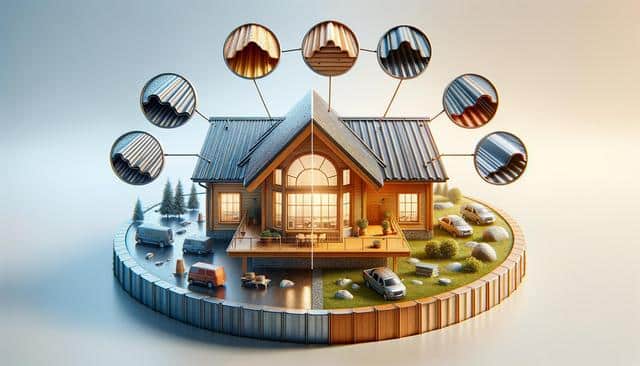
Metal Roofing: Weighing the Advantages and Disadvantages
Durability and Longevity
One of the most notable advantages of metal roofing is its long-lasting durability. Homeowners often choose metal because it can withstand a wide range of environmental conditions. Unlike traditional asphalt shingles, metal roofing is resistant to cracking, shrinking, and eroding. With proper installation and maintenance, a metal roof can last 40 to 70 years, significantly longer than many other roofing materials. This longevity makes it a cost-effective investment over time, even if the upfront costs are higher.
Metal is also resistant to insect damage, mildew, and rot—common issues with wood-based roofing. Additionally, it performs well in regions prone to severe weather, including heavy snow, hail, and high winds. This resilience reduces the need for frequent repairs and replacements, saving homeowners both time and money in the long run.
- Resistant to rot and insect damage
- Can last several decades with minimal maintenance
- Performs well in extreme weather conditions
These benefits are especially valuable in areas with fluctuating climates, where other roofing materials might deteriorate more quickly. However, durability doesn’t mean invincibility, and homeowners should still plan for occasional inspections and minor upkeep.
Energy Efficiency and Environmental Impact
Metal roofing offers strong energy efficiency benefits, making it a popular choice among eco-conscious homeowners. The reflective properties of metal surfaces help reduce heat absorption, particularly during the summer months. This can lead to lower cooling costs, as the roof reflects solar radiant heat instead of absorbing it.
In many cases, metal roofs are coated with special finishes that further improve solar reflectance and thermal emittance. These coatings contribute to maintaining a consistent indoor temperature and reducing air conditioning usage. This makes metal roofing an effective option for those looking to minimize their environmental footprint and utility expenses.
- Reflects sunlight, reducing heat gain
- Can be made from recycled materials
- Fully recyclable at the end of its life
Beyond energy savings, metal roofs are often made from recycled materials and are fully recyclable themselves. This contrasts with asphalt shingles, which typically end up in landfills. As a result, metal roofing contributes less to construction waste and supports sustainable building practices.
Initial Costs and Installation Considerations
Despite its long-term value, one of the primary drawbacks of metal roofing is the initial cost. Metal materials and installation typically cost more than asphalt shingles or other common roofing options. This can be a barrier for homeowners working with a limited budget, especially if the roof needs to be replaced unexpectedly.
Installation is another important factor. Because metal roofing requires specific tools and expertise, not all contractors are equipped to handle it. Improper installation can lead to issues like leaks, reduced energy efficiency, or even structural damage. Homeowners should seek out qualified professionals with experience in metal roofing to ensure the job is done correctly.
- Higher upfront material and labor costs
- Requires skilled installation
- May need additional structural support
In some cases, additional structural modifications may be necessary to support the weight and configuration of the metal roof, especially for retrofitting projects. These additional expenses can increase the total project cost, making it important to factor in all relevant considerations before committing.
Sound and Insulation Performance
Another aspect to consider with metal roofing is its acoustic performance. During heavy rain or hailstorms, metal roofs can produce more noise than other materials. While some homeowners enjoy the sound of rain on a metal roof, others may find it disruptive. This noise can be mitigated with proper insulation and underlayment, but these solutions may add to the installation cost.
Thermal insulation is also crucial. Although metal itself is a conductor, modern metal roofing systems often include insulating layers that help regulate indoor temperatures. When paired with appropriate attic insulation and ventilation, metal roofs can contribute to a comfortable and energy-efficient home environment.
- Can be noisier during storms without insulation
- Needs quality underlayment for sound dampening
- Performs well with proper thermal insulation
It’s worth noting that soundproofing and insulation are areas where homeowners can customize their roofing setup. Choosing higher-grade materials and working with knowledgeable contractors can significantly improve both comfort and performance.
Aesthetic Versatility and Property Value
Metal roofing has evolved significantly in terms of aesthetics. Modern metal roofs come in a variety of styles, colors, and finishes that can complement almost any architectural design—from traditional homes to contemporary builds. Some metal roofing systems even mimic the look of shingles, tiles, or slate, offering visual appeal without compromising durability.
This design flexibility can enhance curb appeal and potentially increase the resale value of a home. Buyers may view a metal roof as a long-term benefit, appreciating its low maintenance and energy-saving qualities. This can make a property more attractive in competitive housing markets.
- Available in many colors and styles
- Can simulate traditional roofing materials
- May increase home resale value
However, not all communities approve of metal roofing, especially in neighborhoods with strict homeowners’ association guidelines. It’s important to check local regulations and obtain necessary approvals before installation. Aesthetic preferences vary, and while many find metal roofs stylish and modern, others may prefer more classic materials.
Conclusion: Is Metal Roofing Right for You?
Choosing a metal roof involves careful consideration of your home’s needs, local climate, and budget. The material offers numerous advantages, including long lifespan, energy efficiency, and low maintenance. At the same time, it comes with higher initial costs and may require enhanced insulation to manage noise and temperature.
For homeowners planning to stay in their property long-term or those seeking an environmentally friendly option, metal roofing presents a worthwhile investment. However, it’s essential to weigh the pros and cons in the context of your specific goals and resources. Consulting with experienced roofing professionals and reviewing local building regulations can further guide your decision toward a solution that aligns with both your aesthetic preferences and functional requirements.


